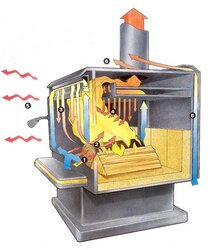The available tax credit has sparked my interest in replacing my Wenlock wood/coal combination stove with a EPA efficent wood stove. I have two questions on the stainless steel tubes used to circulate hot air on the exiting gases. Has anyone seen a diagram on the air flow which shows where the air circulates from and how it enters the tubes. What is the life expectancy of these tubes since they live in the hottest part of the stove. Also, do you think I will see a significant improvement in efficency to justify spending $2,000. to replace a stove that does work fairly well.
EPA Efficient Stoves
- Thread starter Backwoodsman
- Start date
-
Active since 1995, Hearth.com is THE place on the internet for free information and advice about wood stoves, pellet stoves and other energy saving equipment.
We strive to provide opinions, articles, discussions and history related to Hearth Products and in a more general sense, energy issues.
We promote the EFFICIENT, RESPONSIBLE, CLEAN and SAFE use of all fuels, whether renewable or fossil.


